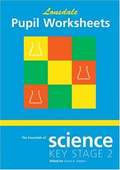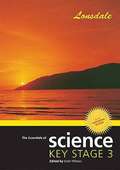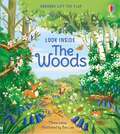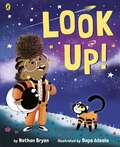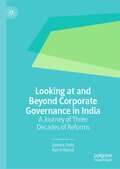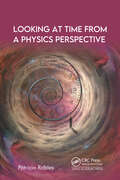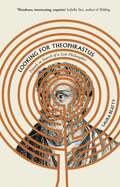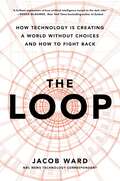- Table View
- List View
Lonsdale Science: Pupil Worksheets (Key Stage 2 Essentials) (PDF)
by Grace A AdamsThese worksheets provide further practice to test and reinforce understanding of the material covered in the KS2 Science Revision Guide.nbsp;
Lonsdale Science Key Stage 3: Revision Guide (PDF)
by Katie WhelanSuitable for levels 3-7 inclusive, this best selling revision guide distils the Programme of Study for KS3 Science down to the essentials, to provide an invaluable recap of all the key topics to strengthen learning and support preparation for tests and assessments.
Look Inside the Woods: (PDF)
by Minna LaceyLook through the trees, see under leaves and discover what's lurking behind the bushes in this beautifully illustrated flap-book. Young nature lovers will enjoy opening the flaps to discover hidden animals and amazing facts. Look out for birds, squirrels, foxes and bears and find out how trees and woods help make our planet a better place to live.
Look Up!
by Nathan Bryon3 ... 2 ... 1 ... LIFT OFF. Let science-mad chatterbox Rocket launch into your hearts in this inspiring picture book from two incredible debut talents.Rocket's going to be the greatest astronaut, star-catcher, space-traveller that has ever lived!But...First, she needs to convince her big brother Jamal to stop looking down at his phone and start LOOKING UP at the stars.----Bursting with energy and passion about space and the natural world, this heart-warming picture book will reignite your desire to turn off those screens and switch on to the outside world.
Look Up: Why Space Is For Everyone... And Why It Matters
by Sarah Cruddas‘Sarah Cruddas is a gifted writer and Look Up is an inspired book. I am hopeful that we will never stop looking up.’ Apollo 11 astronaut Michael Collins
Looking at and Beyond Corporate Governance in India: A Journey of Three Decades of Reforms
by Seema Joshi Ruchi KansilThis book explores theoretical and empirical perspectives on corporate governance and sustainability and reflects upon India’s three decades of corporate governance reforms. It provides a solid base of information culled from extensive empirical research. It will contribute to the 2030 agenda of the United Nations on Sustainable Development Goals by lighting the way forward and enhancing the convergence of corporate governance with sustainability in business entities. Adopting a credible and uniform sustainability reporting framework and cultivating a pervasive “sustainability culture” through effective “sustainability leadership” has become a business imperative. It will be highly relevant for all stakeholders, including shareholders, boards of directors, managers, academicians, and researchers, and it will empower, enrich, and enable them to gain more conceptual clarity and empirical understanding of corporate governance and sustainability issues. In addition, it shows the pathway for policymakers and practitioners to address the myriad challenges that emanate from sustainability by suggesting new approaches emerging in the critical domain of corporate governance.
Looking at it from Asia: The Processes That Shaped The Sources Of History Of Science (Boston Studies in the Philosophy and History of Science #265)
by Karine Chemla Catherine Jami Agathe Keller Christine ProustHow do Documents Become Sources? Perspectives from Asia and Science Florence Bretelle-Establet From Documents to Sources in Historiography The present volume develops a specific type of critical analysis of the written documents that have become historians’ sources. For reasons that will be explained later, the history of science in Asia has been taken as a framework. However, the issue addressed is general in scope. It emerged from reflections on a problem that may seem common to historians: why, among the huge mass of written documents available to historians, some have been well studied while others have been dismissed or ignored? The question of historical sources and their (unequal) use in historiography is not new. Which documents have been used and favored as historical sources by historians has been a key historiographical issue that has occupied a large space in the historical production of the last four decades, in France at least.
Looking at Ribozymes: Biology of Catalytic RNA
by Benoît MasquidaBehind the neologism “ribozymes” lies a family of fascinating molecules, ribo-enzymes, which have been relatively little studied. These catalytically active RNAs are found in all strata of life, from viruses to the human genome. At the end of the 1970s, the discovery of a catalytic RNA nestled in an intron, followed by another involved in the maturation of transfer RNAs, led to the discovery of new ribozymes and the transition from a strictly “proteocentric” vision, inherited from the dogma of molecular biology, to a more “nucleocentric” one. Since then, a variety of ribozymes have been identified in genomes, where their functions often remain mysterious. Looking at Ribozymes traces the discovery of these molecules and presents a picture of their functional diversity, catalytic mechanisms and distribution within the tree of life.
Looking at Ribozymes: Biology of Catalytic RNA
by Benoît MasquidaBehind the neologism “ribozymes” lies a family of fascinating molecules, ribo-enzymes, which have been relatively little studied. These catalytically active RNAs are found in all strata of life, from viruses to the human genome. At the end of the 1970s, the discovery of a catalytic RNA nestled in an intron, followed by another involved in the maturation of transfer RNAs, led to the discovery of new ribozymes and the transition from a strictly “proteocentric” vision, inherited from the dogma of molecular biology, to a more “nucleocentric” one. Since then, a variety of ribozymes have been identified in genomes, where their functions often remain mysterious. Looking at Ribozymes traces the discovery of these molecules and presents a picture of their functional diversity, catalytic mechanisms and distribution within the tree of life.
Looking at Time from a Physics Perspective
by Patricio RoblesThe subject of time continues to be a subject of extensive research in the development of new theories of physics. This new volume is addressed to students who are starting a graduate program in physics or electrical engineering interested in complementing their studies of relativity theory and quantum physics, applying the knowledge they have acquired about these themes to the analysis of situations where the issue of time measurement is relevant. This is the case, for example, of clock synchronization, transit times of optical signals through dielectric and absorbing media, lifetimes of excited atomic states, among others. These topics, in addition to being of great importance to theoretical physicists, are the basis of many technological developments. For example, global positional systems (GPS) are based on the predictions of relativity theory about time and the effect of gravity over time measurement.Divided into six chapters, the volume discusses how the concept of time is present in the main fields of physics, such as classical mechanics, electrodynamics, quantum mechanics and theory of relativity. Illustrative examples and case studies are included in each chapter. The volume includes an analysis of themes related to time such as causality and the arrows of time, spooky action at distance and Einstein-Podolsky-Rosen Paradox, quantum mechanics and entangled states, apparent superluminal velocity, and time reversal.This book, Looking at Time from a Physics Perspective, will contribute to the understanding of concepts learned in courses on classical mechanics, electrodynamics, quantum mechanics and relativity, reviewing the implications of the time variable for the description of the different physical phenomena at the microscopic and macroscopic level.
Looking at Time from a Physics Perspective
by Patricio RoblesThe subject of time continues to be a subject of extensive research in the development of new theories of physics. This new volume is addressed to students who are starting a graduate program in physics or electrical engineering interested in complementing their studies of relativity theory and quantum physics, applying the knowledge they have acquired about these themes to the analysis of situations where the issue of time measurement is relevant. This is the case, for example, of clock synchronization, transit times of optical signals through dielectric and absorbing media, lifetimes of excited atomic states, among others. These topics, in addition to being of great importance to theoretical physicists, are the basis of many technological developments. For example, global positional systems (GPS) are based on the predictions of relativity theory about time and the effect of gravity over time measurement.Divided into six chapters, the volume discusses how the concept of time is present in the main fields of physics, such as classical mechanics, electrodynamics, quantum mechanics and theory of relativity. Illustrative examples and case studies are included in each chapter. The volume includes an analysis of themes related to time such as causality and the arrows of time, spooky action at distance and Einstein-Podolsky-Rosen Paradox, quantum mechanics and entangled states, apparent superluminal velocity, and time reversal.This book, Looking at Time from a Physics Perspective, will contribute to the understanding of concepts learned in courses on classical mechanics, electrodynamics, quantum mechanics and relativity, reviewing the implications of the time variable for the description of the different physical phenomena at the microscopic and macroscopic level.
Looking Back in Crime: What Happened on This Date in Criminal Justice History?
by James O. WindellJust as people are captivated by murder mysteries, detective stories, and legal shows, they are also compulsively interested in the history of criminal justice. Looking Back in Crime: What Happened on This Day in Criminal Justice History? features a treasure trove of important dates and significant events in criminal justice history.Offering hundre
Looking Deep in the Southern Sky: Proceedings of the ESO/Australia Workshop Held at Sydney, Australia, 10–12 December 1997 (ESO Astrophysics Symposia)
by Raffaella Morganti Warrick J. CouchThe idea of a joint ESO / Australia meeting on the large number of exciting new facilities that are, or will soon be, available tihne southern hemisphere arose quite naturally. In the optical and the near-infrared, the Very Large Telescope (VLT) will soon be operational. In the radio, the Australia Telescope Com pact Array is going to be upgraded to higher frequencies (20 and 100 GHz), together with an improvement in very long baseline interferometry (VLBI) facil ities. Other major facilities, such as the Large Millimetre Array and the lkT are being planned. Moreover, new deep surveys are underway in the southern hemi sphere: the southern Hubble Deep Field, the ESO Imaging Survey (BIS), pan oramic deep surveys with the UK Schmidt telescope, and the Anglo-Australian Telescope (AAT) 2dF galaxy/QSO redshift survey in the optical; and the Parkes multibeam HI survey and Molonglo Observatory Synthesis Telescope (MOST) Wide Field continuum survey at radio wavelengths. With all these new facilities, important progress will be made regarding important issues such as the large scale structure of the universe, the very early universe and the associated first epoch of galaxy formation. The generation of large databases, and the oppor tunity for sensitive follow-up observations in complementary wavebands, mean that coordinated radio, infrared and optical projects in the southern hemisphere are likely to become increasingly attractive and important.
Looking for a Few Good Males: Female Choice in Evolutionary Biology (Animals, History, Culture)
by Erika L. MilamWhy do female animals select certain mates, and how do scientists determine the answer? In considering these questions, Erika Lorraine Milam explores the fascinating patterns of experiment and interpretation that emerged as twentieth-century researchers studied sexual selection and female choice. Approaching the topic from both biological and animal-studies perspectives, Milam not only presents a broad history of sexual selection—from Darwin to sociobiology—but also analyzes the animal-human continuum from the perspectives of sex, evolution, and behavior. She asks how social and cultural assumptions influence human-animal research and wonders about the implications of gender on scientific outcomes. Although female choice appears to be a straightforward theoretical concept, the study of sexual selection has been anything but simple. Scientists in the early twentieth century investigated female choice in animals but did so with human social and sexual behavior as their ultimate objective. By the 1940s, evolutionary biologists and population geneticists shifted their focus, studying instead how evolution affected natural animal populations. Two decades later, organismal biologists once again redefined the investigation of sexual selection as sociobiology came to dominate the discipline.Outlining the ever-changing history of this field of study, Milam uncovers lost mid-century research programs and finds that the discipline did not languish in the decades between Darwin’s theory of sexual selection and sociobiology, as observers commonly believed. Rather, population geneticists, ethologists, and organismal biologists alike continued to investigate this important theory throughout the twentieth century.
Looking for Theophrastus: Travels in Search of a Lost Philosopher
by Laura BeattyWho is Theophrastus, and why should we care?Once, he was the equal of Plato and Aristotle. Together he and Aristotle invented science. Alone he invented Botany. The character of the Wife of Bath is his invention, the Canterbury Tales as a whole, perhaps, the product of his inspiration. When Linnaeus was developing our modern system of plant taxonomy, it was Theophrastus' work on plants that he used as a basis. So how could one man do so much and still sink almost without a trace?This is the story of a journey to find him and bring him back from oblivion. Looking for Theophrastus, in all the places he must have walked and lived, it tells how he and Aristotle, his friend and tutor, broke with the philosophical conventions of the Academy and left on their own adventure; of how together they invented what we now take for granted as the Natural Sciences; how, not content with that, they made the great experiment of applying philosophy directly to the practicalities of government through the tutoring of Alexander the Great; how they were disappointed and how, in the end, they returned to Athens and founded the famous Lyceum.Against the dramatic context of his time - the end of democracy in Athens and the rise of Alexander the Great; the great battles and vast territorial expansion that followed; the flowering of the philosophy schools on which so much of our culture and thinking is founded - and on, following his cultural legacy through to the modern day, it explores how we perceive, understand and, most importantly, how we relate to the world around us, questioning what we lose from our way of living when we forget those ancients who first taught us how to see.
Looking Forward: Prediction and Uncertainty in Modern America
by Jamie L. PietruskaIn the decades after the Civil War, the world experienced monumental changes in industry, trade, and governance. As Americans faced this uncertain future, public debate sprang up over the accuracy and value of predictions, asking whether it was possible to look into the future with any degree of certainty. In Looking Forward, Jamie L. Pietruska uncovers a culture of prediction in the modern era, where forecasts became commonplace as crop forecasters, “weather prophets,” business forecasters, utopian novelists, and fortune-tellers produced and sold their visions of the future. Private and government forecasters competed for authority—as well as for an audience—and a single prediction could make or break a forecaster’s reputation. Pietruska argues that this late nineteenth-century quest for future certainty had an especially ironic consequence: it led Americans to accept uncertainty as an inescapable part of both forecasting and twentieth-century economic and cultural life. Drawing together histories of science, technology, capitalism, environment, and culture, Looking Forward explores how forecasts functioned as new forms of knowledge and risk management tools that sometimes mitigated, but at other times exacerbated, the very uncertainties they were designed to conquer. Ultimately Pietruska shows how Americans came to understand the future itself as predictable, yet still uncertain.
Looking Forward: Prediction and Uncertainty in Modern America
by Jamie L. PietruskaIn the decades after the Civil War, the world experienced monumental changes in industry, trade, and governance. As Americans faced this uncertain future, public debate sprang up over the accuracy and value of predictions, asking whether it was possible to look into the future with any degree of certainty. In Looking Forward, Jamie L. Pietruska uncovers a culture of prediction in the modern era, where forecasts became commonplace as crop forecasters, “weather prophets,” business forecasters, utopian novelists, and fortune-tellers produced and sold their visions of the future. Private and government forecasters competed for authority—as well as for an audience—and a single prediction could make or break a forecaster’s reputation. Pietruska argues that this late nineteenth-century quest for future certainty had an especially ironic consequence: it led Americans to accept uncertainty as an inescapable part of both forecasting and twentieth-century economic and cultural life. Drawing together histories of science, technology, capitalism, environment, and culture, Looking Forward explores how forecasts functioned as new forms of knowledge and risk management tools that sometimes mitigated, but at other times exacerbated, the very uncertainties they were designed to conquer. Ultimately Pietruska shows how Americans came to understand the future itself as predictable, yet still uncertain.
Looking Forward: Prediction and Uncertainty in Modern America
by Jamie L. PietruskaIn the decades after the Civil War, the world experienced monumental changes in industry, trade, and governance. As Americans faced this uncertain future, public debate sprang up over the accuracy and value of predictions, asking whether it was possible to look into the future with any degree of certainty. In Looking Forward, Jamie L. Pietruska uncovers a culture of prediction in the modern era, where forecasts became commonplace as crop forecasters, “weather prophets,” business forecasters, utopian novelists, and fortune-tellers produced and sold their visions of the future. Private and government forecasters competed for authority—as well as for an audience—and a single prediction could make or break a forecaster’s reputation. Pietruska argues that this late nineteenth-century quest for future certainty had an especially ironic consequence: it led Americans to accept uncertainty as an inescapable part of both forecasting and twentieth-century economic and cultural life. Drawing together histories of science, technology, capitalism, environment, and culture, Looking Forward explores how forecasts functioned as new forms of knowledge and risk management tools that sometimes mitigated, but at other times exacerbated, the very uncertainties they were designed to conquer. Ultimately Pietruska shows how Americans came to understand the future itself as predictable, yet still uncertain.
Looking Forward: Prediction and Uncertainty in Modern America
by Jamie L. PietruskaIn the decades after the Civil War, the world experienced monumental changes in industry, trade, and governance. As Americans faced this uncertain future, public debate sprang up over the accuracy and value of predictions, asking whether it was possible to look into the future with any degree of certainty. In Looking Forward, Jamie L. Pietruska uncovers a culture of prediction in the modern era, where forecasts became commonplace as crop forecasters, “weather prophets,” business forecasters, utopian novelists, and fortune-tellers produced and sold their visions of the future. Private and government forecasters competed for authority—as well as for an audience—and a single prediction could make or break a forecaster’s reputation. Pietruska argues that this late nineteenth-century quest for future certainty had an especially ironic consequence: it led Americans to accept uncertainty as an inescapable part of both forecasting and twentieth-century economic and cultural life. Drawing together histories of science, technology, capitalism, environment, and culture, Looking Forward explores how forecasts functioned as new forms of knowledge and risk management tools that sometimes mitigated, but at other times exacerbated, the very uncertainties they were designed to conquer. Ultimately Pietruska shows how Americans came to understand the future itself as predictable, yet still uncertain.
Looking Inside Jets: An Introduction to Jet Substructure and Boosted-object Phenomenology (Lecture Notes in Physics #958)
by Simone Marzani Gregory Soyez Michael SpannowskyThis concise primer reviews the latest developments in the field of jets. Jets are collinear sprays of hadrons produced in very high-energy collisions, e.g. at the LHC or at a future hadron collider. They are essential to and ubiquitous in experimental analyses, making their study crucial. At present LHC energies and beyond, massive particles around the electroweak scale are frequently produced with transverse momenta that are much larger than their mass, i.e., boosted. The decay products of such boosted massive objects tend to occupy only a relatively small and confined area of the detector and are observed as a single jet. Jets hence arise from many different sources and it is important to be able to distinguish the rare events with boosted resonances from the large backgrounds originating from Quantum Chromodynamics (QCD). This requires familiarity with the internal properties of jets, such as their different radiation patterns, a field broadly known as jet substructure. This set of notes begins by providing a phenomenological motivation, explaining why the study of jets and their substructure is of particular importance for the current and future program of the LHC, followed by a brief but insightful introduction to QCD and to hadron-collider phenomenology. The next section introduces jets as complex objects constructed from a sequential recombination algorithm. In this context some experimental aspects are also reviewed. Since jet substructure calculations are multi-scale problems that call for all-order treatments (resummations), the bases of such calculations are discussed for simple jet quantities. With these QCD and jet physics ingredients in hand, readers can then dig into jet substructure itself. Accordingly, these notes first highlight the main concepts behind substructure techniques and introduce a list of the main jet substructure tools that have been used over the past decade. Analytic calculations are then provided for several families of tools, the goal being to identify their key characteristics. In closing, the book provides an overview of LHC searches and measurements where jet substructure techniques are used, reviews the main take-home messages, and outlines future perspectives.
Looking Inside the Brain: The Power of Neuroimaging
by Denis Le Bihan Teresa Lavender FaganIt is now possible to witness human brain activity while we are talking, reading, or thinking, thanks to revolutionary neuroimaging techniques like magnetic resonance imaging (MRI). These groundbreaking advances have opened infinite fields of investigation—into such areas as musical perception, brain development in utero, and faulty brain connections leading to psychiatric disorders—and have raised unprecedented ethical issues. In Looking Inside the Brain, one of the leading pioneers of the field, Denis Le Bihan, offers an engaging account of the sophisticated interdisciplinary research in physics, neuroscience, and medicine that have led to the remarkable neuroimaging methods that give us a detailed look into the human brain.Introducing neurological anatomy and physiology, Le Bihan walks readers through the historical evolution of imaging technology—from the x-ray and CT scan to the PET scan and MRI—and he explains how neuroimaging uncovers afflictions like stroke or cancer and the workings of higher-order brain activities, such as language skills. Le Bihan also takes readers on a behind-the-scenes journey through NeuroSpin, his state-of-the-art neuroimaging laboratory, and goes over the cutting-edge scanning devices currently being developed. Considering what we see when we look at brain images, Le Bihan weighs what might be revealed about our thoughts and unconscious, and discusses how far this technology might go in the future.Beautifully illustrated in color, Looking Inside the Brain presents the trailblazing story of the scanning techniques that provide keys to previously unimagined knowledge of our brains and our selves.
Looking Inside the Brain: The Power of Neuroimaging
by Denis Le Bihan Teresa Lavender FaganIt is now possible to witness human brain activity while we are talking, reading, or thinking, thanks to revolutionary neuroimaging techniques like magnetic resonance imaging (MRI). These groundbreaking advances have opened infinite fields of investigation—into such areas as musical perception, brain development in utero, and faulty brain connections leading to psychiatric disorders—and have raised unprecedented ethical issues. In Looking Inside the Brain, one of the leading pioneers of the field, Denis Le Bihan, offers an engaging account of the sophisticated interdisciplinary research in physics, neuroscience, and medicine that have led to the remarkable neuroimaging methods that give us a detailed look into the human brain.Introducing neurological anatomy and physiology, Le Bihan walks readers through the historical evolution of imaging technology—from the x-ray and CT scan to the PET scan and MRI—and he explains how neuroimaging uncovers afflictions like stroke or cancer and the workings of higher-order brain activities, such as language skills. Le Bihan also takes readers on a behind-the-scenes journey through NeuroSpin, his state-of-the-art neuroimaging laboratory, and goes over the cutting-edge scanning devices currently being developed. Considering what we see when we look at brain images, Le Bihan weighs what might be revealed about our thoughts and unconscious, and discusses how far this technology might go in the future.Beautifully illustrated in color, Looking Inside the Brain presents the trailblazing story of the scanning techniques that provide keys to previously unimagined knowledge of our brains and our selves.
The Loom of Life: Unravelling Ecosystems
by Menno SchilthuizenIn an age of increasing environmental problems, ecology has had to grow up fast from a discipline dealing with relatively simple interactions between species to one that tries to explain changes in global patterns of diversity and richness. The issues are complex. Every species may seem to have its own unique role, but if that is true, then why are there hundreds of species of plankton in an ecosystem with only a handful of niches? The tropics have a high biodiversity, but does anybody know why? And how can a single introduced tree species wreak havoc in Hawaii’s rainforests, when it is one of thousands of quietly coexisting tree species in its native continent, South America?The strength of this book is that it will help digest some of these more complex issues in the ecology of biodiversity. It will do this by zooming out from the local scale to the global scale in a number of steps, marrying community ecology with macroecology, and introducing unexpected nuggets of natural history along the way. The reader will notice that, the larger the scale, the more the familiar niche-concept appears to be overshadowed by exotic fields from fractal and complexity theory. However, scientists differ in opinion on the scale at which niches become irrelevant. These differences of opinion, but also the search for unified ecological theories, will form another force by which the story will be carried along to its conclusion. A conclusion which, surprisingly, seeks to find a glimpse of the globe's future in the traces from its past.
The Loop: How Technology is Creating a World Without Choices and How to Fight Back
by Jacob WardAn eye-opening narrative journey into the rapidly changing world of artificial intelligence, revealing the dangerous ways that AI is poised to exploit the unconscious habits of our mindsArtificial intelligence is going to change the world as we know it. But the real danger isn't some robot that's going to enslave us: It's our own brain. Our brains are constantly making decisions using shortcuts, biases, and hidden processes-and we're using those same techniques to create technology that makes choices for us. In The Loop, award-winning science journalist Jacob Ward reveals how we are poised to build all of our worst instincts into our AIs, creating a narrow loop where each generation has fewer, predetermined, and even dangerous choices.Taking us on a world tour of the ongoing, real-world experiment of artificial intelligence, The Loop illuminates the dangers of writing dangerous human habits into our machines. From a biometric surveillance state in India that tracks the movements of over a billion people, to a social media control system in China that punishes deviant friendships, to the risky multiple-choice simplicity of automated military action, Ward travels the world speaking with top experts confronting the perils of their research. Each stop reveals how the most obvious patterns in our behavior-patterns an algorithm will use to make decisions about what's best for us-are not the ones we want to perpetuate. Just as politics, marketing, and finance have all exploited the weaknesses of our human programming, artificial intelligence is poised to use the patterns of our lives to manipulate us. The Loop is call to look at ourselves more clearly-our most creative ideas, our most destructive impulses, the ways we help and hurt one another-so we can put only the best parts of ourselves into the thinking machines we create.
